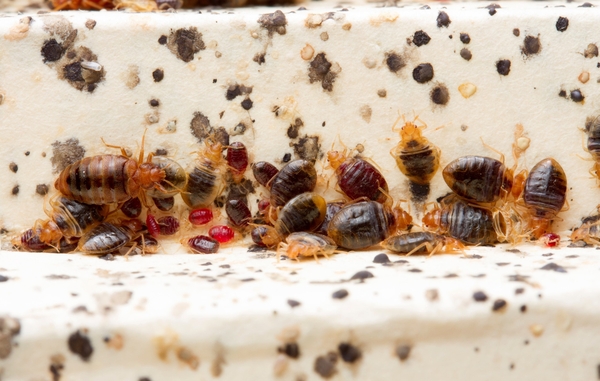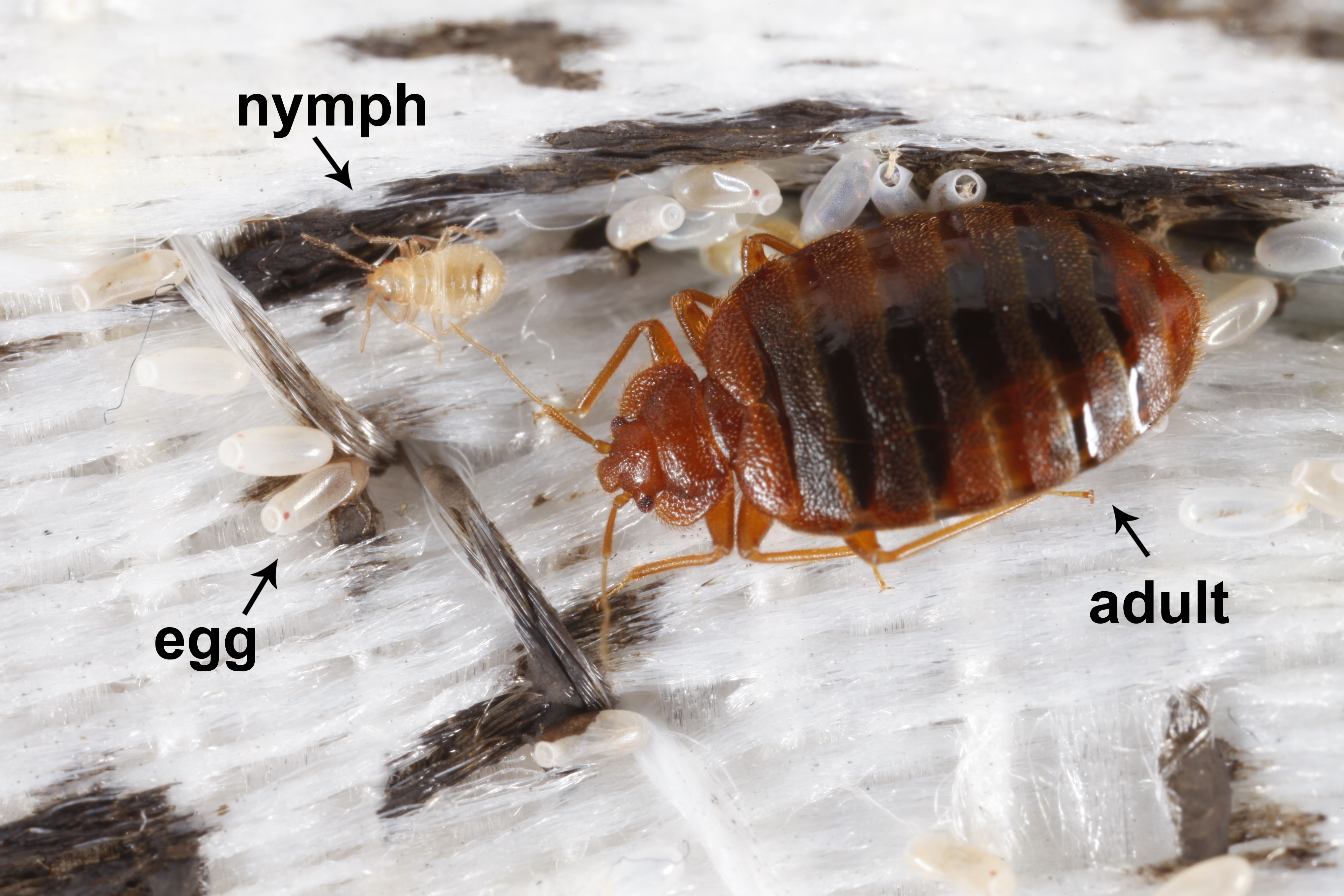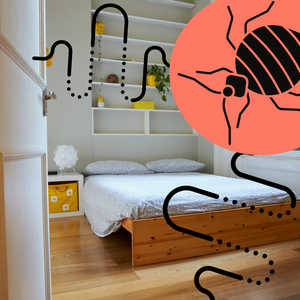To stop bed bugs from spreading to other rooms, isolate infested items, seal cracks, and use a vacuum and hot dryer. Properly inspect and treat all areas to prevent further infestation.
Dealing with a bed bug infestation can be a frustrating and challenging experience. These pests can quickly spread from room to room, making it crucial to take immediate action to prevent their further spread. We will discuss effective methods to stop bed bugs from spreading to other rooms and provide essential tips to eliminate and prevent their infestation.
By following the recommended strategies, you can effectively contain and eradicate bed bugs, ensuring a pest-free home environment.

Credit: content.ces.ncsu.edu
Identifying Bed Bugs
Recognizing signs of bed bug infestation:
- Check for small reddish-brown bugs in the seams of your mattress.
- Look for tiny bloodstains on your sheets or pillowcases.
- Notice dark spots or eggshells in crevices near your bed.
Inspecting your bed and furniture:
- Use a flashlight to examine box springs, headboards, and bed frames.
- Check upholstered furniture for bed bug presence.
- Vacuum and clean your mattress regularly to prevent infestations.
Preventive Measures
Preventive Measures:
Creating A Barrier
To prevent bed bugs from spreading to other rooms, create a barrier around your bed with interceptor traps.
Sealing Cracks And Crevices
Seal cracks and crevices in walls, floors, and furniture to limit bed bug movement.
Reducing Clutter
Reduce clutter to eliminate hiding spots for bed bugs and make treatment easier.
Bed Bug Treatment
Dealing with a bed bug infestation can be a frustrating and stressful experience. These tiny insects can quickly multiply and spread to other rooms if not treated effectively. To prevent the bed bugs from spreading, it is crucial to implement proper bed bug treatment methods. Here are some effective ways to stop bed bugs from infesting other areas of your home:
Washing And Drying Infested Items
One of the first steps in bed bug treatment is to wash and dry all infested items, including bedding, clothing, and curtains. This process helps to eliminate any bed bugs and their eggs. Follow these steps:
- Place infested items into plastic bags immediately to prevent the insects from spreading.
- Wash the items in hot water, preferably above 120°F (49°C).
- Use a mild detergent and bed bug laundry additive, if available.
- Dry the items on high heat for at least 30 minutes to kill any remaining bed bugs.
- Once dry, store the items in sealed plastic bags to prevent re-infestation.
Vacuuming And Steaming
Vacuuming and steaming are effective methods to eliminate bed bugs and their eggs from various surfaces. Follow these steps:
- Vacuum all affected areas, including mattresses, upholstery, carpets, and cracks or crevices.
- Dispose of the vacuum bag or empty the canister into a sealed plastic bag immediately after vacuuming.
- Using a steam cleaner, treat all infested areas, paying special attention to mattresses, bed frames, and furniture.
- Ensure the steam temperature is at least 160°F (71°C) to effectively kill the bed bugs.
- Repeat these steps regularly to ensure complete eradication.
Using Insecticides
Insecticides are a common solution for bed bug treatment, but they should be used with caution. Always read and follow the label instructions carefully. Here are some tips:
- Choose an insecticide specifically labeled for indoor use and bed bug treatment.
- Apply the insecticide to cracks, crevices, and other hiding spots where bed bugs are likely to be found.
- Avoid spraying the insecticide directly on bedding, furniture, or areas where people come in direct contact.
- Wear protective clothing and use appropriate safety precautions.
- Reapply the insecticide as directed, typically after a few weeks.
Contacting Professional Exterminators
If your bed bug infestation persists or if you prefer to leave the treatment to professionals, it is advisable to contact a professional exterminator. Professional exterminators have the knowledge, experience, and specialized tools to effectively eliminate bed bugs from your home. They can provide a thorough inspection, identify the extent of the infestation, and develop a targeted treatment plan.
By following these bed bug treatment methods, you can prevent the spread of these pesky insects to other rooms in your home. Remember to act quickly and be diligent in your treatment efforts to achieve the best results.

Credit: extension.entm.purdue.edu
Isolating Infested Areas
Isolating infested areas is crucial in preventing bed bugs from spreading to other rooms. By following these steps, you can effectively contain the infestation and minimize the risk of further spread.
Identifying Affected Rooms
To begin isolating infested areas, it’s essential to identify the rooms that are affected by bed bugs. Inspect all bedrooms, living areas, and furniture for signs of infestation, such as live bugs, eggs, and fecal stains. Once the affected rooms are identified, take immediate steps to isolate them from the rest of the living space.
Using Mattress Encasements
Mattress encasements provide a protective barrier that can contain bed bugs within the infested mattress. By encasing the mattress and box spring with a specially designed cover, you can prevent bed bugs from migrating to other rooms via the bed. Be sure to choose an encasement that is certified bed-bug-proof and fully encloses the mattress and box spring.
Using Interceptors
Interceptors are devices placed under the legs of bed frames, couches, and chairs to capture bed bugs as they attempt to move between rooms. Utilizing interceptors can help to identify and contain bed bugs within the infested areas, preventing them from spreading to other parts of the home. Regularly inspect and clean the interceptors to monitor and control the infestation.
Educating Household Members
Informing everyone about bed bugs is crucial to prevent their spread to other rooms. By educating household members about the signs of bed bugs and the importance of early identification, it becomes easier to contain the infestation.
Informing Everyone About Bed Bugs
It’s essential to educate everyone in the household about bed bugs. You can do this by discussing the appearance of bed bugs, where they are commonly found, and the signs of a bed bug infestation. Empower everyone to be proactive in identifying and reporting any potential bed bug activity in their rooms.
Teaching Prevention Techniques
Educating household members on bed bug prevention techniques is vital. This involves teaching them how to avoid bringing bed bugs home from outside sources, such as when traveling, and how to prevent spreading them within the home. Encourage everyone to maintain a clutter-free environment and regularly inspect and clean their living spaces.

Credit: blog.spotta.co
Travel Precautions
When it comes to preventing the spread of bed bugs to other rooms during your travels, taking necessary precautions is essential. It’s important to be proactive in inspecting hotel rooms and implementing preventive measures to ensure you don’t bring these unwanted guests back home.
Inspecting Hotel Rooms
Before settling into your hotel room, it’s imperative to conduct a thorough inspection to check for any signs of bed bugs. Follow these steps to ensure your room is free from these pests:
- Start by examining the bedding, including the mattress and sheets, for any visible signs of bed bugs such as dark spots, bloodstains, or discarded exoskeletons.
- Inspect the seams, tufts, and crevices of the mattress, as bed bugs often hide in these areas.
- Check the headboard, bed frame, and nearby furniture, as these can serve as potential hiding spots for bed bugs.
- Inspect the upholstered chairs, curtains, and carpeted areas for any signs of infestation.
- Don’t forget to inspect the luggage rack, as bed bugs can easily crawl onto your suitcases.
Taking Preventive Measures While Traveling
To prevent bed bugs from hitching a ride back home with you, follow these precautions during your travels:
- When packing your luggage, opt for hard-shell suitcases or bags with a smooth surface, as these can make it harder for bed bugs to hide.
- Consider using bed bug-proof luggage encasements to provide an extra layer of protection.
- Keep your luggage off the floor and instead, place it on luggage racks, elevated surfaces, or in the bathtub.
- Unpack your belongings onto clean surfaces such as countertops or tables, instead of using hotel furniture.
- Keep clothing and personal items in sealed plastic bags to prevent bed bugs from infiltrating.
By adhering to these travel precautions, you can significantly reduce the chances of spreading bed bugs to other rooms during your journey. Stay vigilant and take the necessary steps to protect yourself and your belongings from these pesky invaders.
Dealing With Infested Items
To prevent bed bugs from spreading to other rooms, it’s crucial to handle infested items with care. This includes proper disposal of infested items and treating infested clothing and linens effectively.
Proper Disposal Of Infested Items
- Seal infested items in plastic bags before disposing of them.
- Label the bags clearly as “infested” to prevent accidental re-use.
- Dispose of infested items in the trash outside your home immediately.
Treating Infested Clothing And Linens
- Wash infested clothing and linens in hot water above 60°C.
- Dry items on the highest heat setting in the dryer for at least 30 minutes.
- Steam clean items that cannot be washed in hot water or dried at high heat.
Monitoring And Follow-up
When it comes to preventing bed bugs from spreading to other rooms, close monitoring and diligent follow-up are crucial. By staying proactive in your efforts, you can effectively contain the infestation and minimize the risk of it spreading further.
Regular Inspection
- Conduct frequent visual inspections of the infested rooms.
- Check for bed bugs in cracks, crevices, furniture, and bedding.
- Use a flashlight and magnifying glass for thorough examination.
Repeating Treatment If Needed
- Follow up with professional exterminators for re-treatment.
- Ensure all affected areas are treated again for complete eradication.
- Monitor treated rooms regularly for any signs of resurgence.
Frequently Asked Questions Of How To Stop Bed Bugs From Spreading To Other Rooms?
How Can I Prevent Bed Bugs From Spreading To Other Rooms?
To prevent bed bugs from spreading to other rooms, it’s important to regularly inspect for signs of infestation, such as dark spots or eggs. Additionally, keep clutter to a minimum, vacuum regularly, and seal any cracks or crevices in walls and furniture to prevent them from spreading.
What Are Some Effective Methods For Treating Bed Bug Infestations?
Some effective methods for treating bed bug infestations include using a vacuum to remove bed bugs and their eggs, using hot water to wash bedding and clothing, and applying insecticide treatments. It’s also important to seek professional help for severe infestations.
Can Bed Bugs Travel From Room To Room On Clothing Or Luggage?
Yes, bed bugs can easily travel from room to room on clothing, luggage, or other personal belongings. It’s important to be cautious when traveling and to inspect and clean all items before bringing them into your home to prevent the spread of bed bugs.
Conclusion
By following these simple preventive measures, you can effectively stop bed bugs from spreading to other rooms in your home. Remember to thoroughly inspect and vacuum your living spaces regularly, isolate infested items, seal cracks and crevices, and wash and dry bedding on high heat.
By taking proactive steps and being vigilant, you can protect your home and prevent the spread of bed bugs to other areas. Sleep tight and bug-free!
Related posts:

I’m MD Tanvir, and I bring years of expertise gained from working closely with pest control companies to the forefront. My journey in the industry has inspired me to launch Bug Battler, a platform aimed at equipping people with the know-how to combat pests autonomously. Through Bug Battler, I aim to empower individuals with practical insights to tackle pest infestations effectively.

